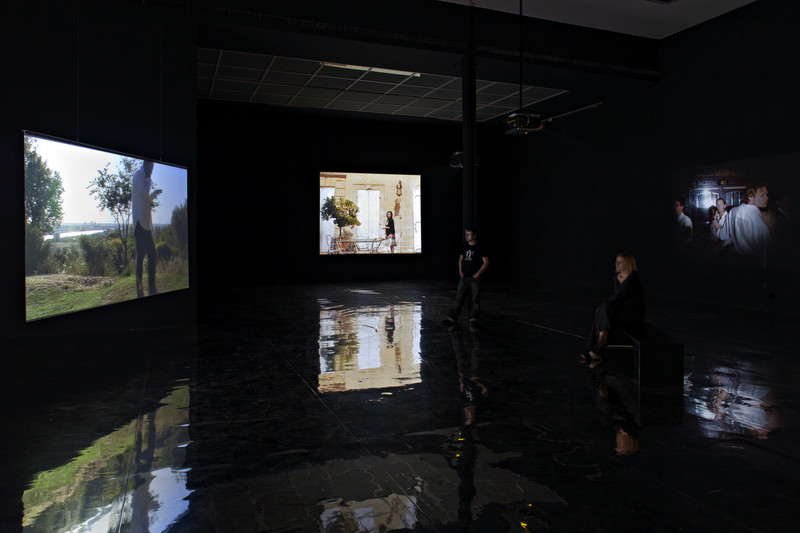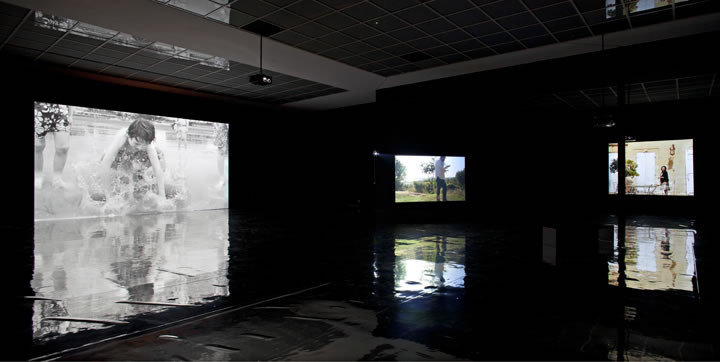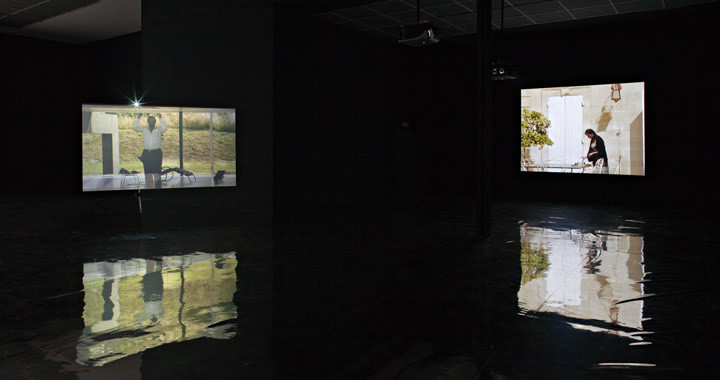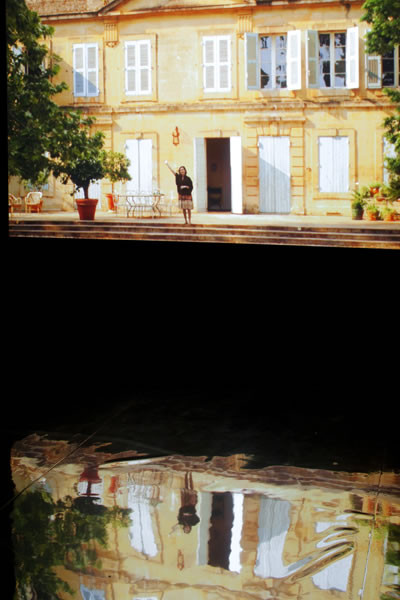David Claerbout
03 May - 17 Jun 2012

David Claerbout: Diese Sonnestrahltimmer, DancingCouples, TheStack / Secession 2012 / Photo: Wolfgang Thaler

David Claerbout: Bordeaux Piece, Long Goodbye, Dancing Couples / Secession 2012 / Photo: Wolfgang Thaler

David Claerbout: Silent Shore, Bordeau Piece, Long Goodbye / Secession 2012 / Photo: Wolfgang Thaler
DAVID CLAERBOUT
Diese Sonne strahlt immer
3 May – 17 June 2012
Traditionally, museum lighting comes from outside of the artworks; it is what makes contemplation of the artworks possible in the first place. Inside the museum, there is usually perfect daylight, even if that light is totally artificial. Media art in the form of video and film installations, on the other hand, has brought night and dusk into the museum."
(Boris Groys, catalogue essay "Film in Art Spaces")
As the motif for invitation cards to Diese Sonne strahlt immer at the Secession, Belgian artist David Claerbout selected a relatively unspectacular-looking snapshot: Rodin's Eve in the entrance hall of the Bauhaus University in Weimar, photographed against dazzling backlight. This photograph, on show in the Hauptraum together with seven film works, is emblematic for Claerbout's first solo show in Austria, where sunlight, a key theme in his work, is made to shine using artificial light. The darkened Hauptraum is lit only by the light from the video projections, that reflects off the silver floor adding an extra shine. "My fascination did not so much come from the intensity of sunlight", Claerbout says, but rather from how a relatively weak projector light can still bring about the memory of intensity in a way that hurts the eye. This simple phenomenon proves that we observe via our memory of things."
In fact, however, the exhibition's title refers to an advertisement for infrared solaria from the 1930s that the artist discovered in Edvard Munch's archive. The advertisement stands for the triumph of electrical over natural light. The former is always available, and it forms the basis for Claerbout's art, enabling lighting and projection. But the protagonist of the video projections in the show is daylight, as an indicator of time.
According to Claerbout, the once opposing characteristics of film (= movement) and photography (= the frozen moment) are no longer so clear. And this is the point from which he developed his own philosophy. Claerbout manipulates time by using the principles of the media of photography and film for both. He digitally animates photographs, for example, depriving them of their static quality—such works include his well known Kindergarten Sant'Elia 1932 (1998) and the Internet project Present (2000). Or he deprives film of its movement: by slowing down human movements in contrast to an accelerated sequence of daylight in Long Goodbye (2007); by the unbearable repetition of the same sequence between sunrise and sunset in Bordeaux Piece (2004); or by animated sequences of photographs showing the same scene over and over again, but from a different viewpoint, as in The Quiet Shore (2011) and The Algiers' Sections of A Happy Moment (2008), both works in which an "animation of time, in the sense of bringing alive" takes place. Photographs, Claerbout says, offer the security of a past moment; the time one spends looking at the photograph is an assurance of the present. In The Quiet Shore and The Algiers' Sections of A Happy Moment, he says, the photographic work relinquishes its exclusive claim to embody the past, while film relinquishes its exclusive claim to stand for the here and now.
Anyone expecting a structured plot will be disappointed: "In my work the pattern of expectation is hampered. (...) Cinematic deliverance is avoided and narrative threads are evaded."* Instead, the stories are told by the following protagonists: the supporting elements of the media of photography and film, i.e., light, music, and composition, symbolized by (modern) architecture. The latter is also often at odds with the strong presence of nature, as in The Stack (2002) or the abovementioned Bordeaux Piece.
Claerbout devotes a great deal of time and attention to his works. In many cases, he photographs or films the original setting and adds in the human protagonists filmed in a blue box later. And viewing his works also takes time. But that is why we go to museums and galleries: "For some reason I am lucky enough to show my works in a gallery, where time's ticking clock can't be heard. That is the point of a museum: looking back." And that is Claerbout's most important tool as a filmmaker: "not the film itself, but memory."*
* David Claerbout in conversation with Inka Graeve Ingelmann, from the catalogue uncertain eye, Pinakothek der Moderne, Munich 2010
Diese Sonne strahlt immer
3 May – 17 June 2012
Traditionally, museum lighting comes from outside of the artworks; it is what makes contemplation of the artworks possible in the first place. Inside the museum, there is usually perfect daylight, even if that light is totally artificial. Media art in the form of video and film installations, on the other hand, has brought night and dusk into the museum."
(Boris Groys, catalogue essay "Film in Art Spaces")
As the motif for invitation cards to Diese Sonne strahlt immer at the Secession, Belgian artist David Claerbout selected a relatively unspectacular-looking snapshot: Rodin's Eve in the entrance hall of the Bauhaus University in Weimar, photographed against dazzling backlight. This photograph, on show in the Hauptraum together with seven film works, is emblematic for Claerbout's first solo show in Austria, where sunlight, a key theme in his work, is made to shine using artificial light. The darkened Hauptraum is lit only by the light from the video projections, that reflects off the silver floor adding an extra shine. "My fascination did not so much come from the intensity of sunlight", Claerbout says, but rather from how a relatively weak projector light can still bring about the memory of intensity in a way that hurts the eye. This simple phenomenon proves that we observe via our memory of things."
In fact, however, the exhibition's title refers to an advertisement for infrared solaria from the 1930s that the artist discovered in Edvard Munch's archive. The advertisement stands for the triumph of electrical over natural light. The former is always available, and it forms the basis for Claerbout's art, enabling lighting and projection. But the protagonist of the video projections in the show is daylight, as an indicator of time.
According to Claerbout, the once opposing characteristics of film (= movement) and photography (= the frozen moment) are no longer so clear. And this is the point from which he developed his own philosophy. Claerbout manipulates time by using the principles of the media of photography and film for both. He digitally animates photographs, for example, depriving them of their static quality—such works include his well known Kindergarten Sant'Elia 1932 (1998) and the Internet project Present (2000). Or he deprives film of its movement: by slowing down human movements in contrast to an accelerated sequence of daylight in Long Goodbye (2007); by the unbearable repetition of the same sequence between sunrise and sunset in Bordeaux Piece (2004); or by animated sequences of photographs showing the same scene over and over again, but from a different viewpoint, as in The Quiet Shore (2011) and The Algiers' Sections of A Happy Moment (2008), both works in which an "animation of time, in the sense of bringing alive" takes place. Photographs, Claerbout says, offer the security of a past moment; the time one spends looking at the photograph is an assurance of the present. In The Quiet Shore and The Algiers' Sections of A Happy Moment, he says, the photographic work relinquishes its exclusive claim to embody the past, while film relinquishes its exclusive claim to stand for the here and now.
Anyone expecting a structured plot will be disappointed: "In my work the pattern of expectation is hampered. (...) Cinematic deliverance is avoided and narrative threads are evaded."* Instead, the stories are told by the following protagonists: the supporting elements of the media of photography and film, i.e., light, music, and composition, symbolized by (modern) architecture. The latter is also often at odds with the strong presence of nature, as in The Stack (2002) or the abovementioned Bordeaux Piece.
Claerbout devotes a great deal of time and attention to his works. In many cases, he photographs or films the original setting and adds in the human protagonists filmed in a blue box later. And viewing his works also takes time. But that is why we go to museums and galleries: "For some reason I am lucky enough to show my works in a gallery, where time's ticking clock can't be heard. That is the point of a museum: looking back." And that is Claerbout's most important tool as a filmmaker: "not the film itself, but memory."*
* David Claerbout in conversation with Inka Graeve Ingelmann, from the catalogue uncertain eye, Pinakothek der Moderne, Munich 2010



